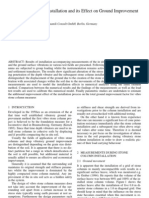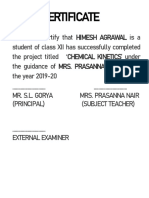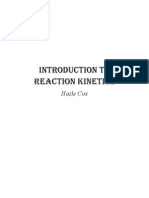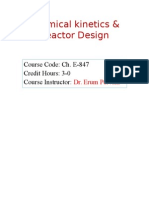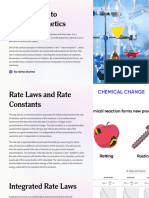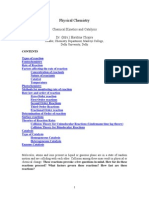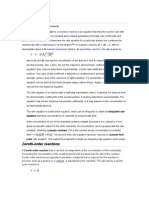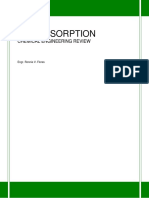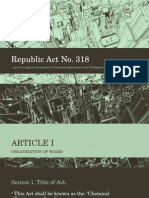Chapter 3 Summary
Chapter 3 Summary
Uploaded by
KTINE08Copyright:
Available Formats
Chapter 3 Summary
Chapter 3 Summary
Uploaded by
KTINE08Original Description:
Copyright
Available Formats
Share this document
Did you find this document useful?
Is this content inappropriate?
Copyright:
Available Formats
Chapter 3 Summary
Chapter 3 Summary
Uploaded by
KTINE08Copyright:
Available Formats
TECHNOLOGICAL INSTITUTE OF THE PHILIPPINES
363 P. CASAL ST., QUIAPO, MANILA
CHEMICAL REACTION ENGINEERING
CHAPTER III SUMMARY
SUBMITTED BY:
KRISTINE ANN F. VILLANUEVA
BSChE/1110630
SUBMITTED TO:
ENGR. LORRAINE A. CARRILLO
PROFESSOR
NOVEMBER 31, 2014
CHAPTER III SUMMARY
RATE LAWS
Rate Laws are essential in Chemical Reaction Engineering. These will serve as the basic step in
solving problems in this course. But before proceeding to rate laws, it is vital that a student
understands what kind of reaction is happening so as to establish the proper equation. Rate Laws
are based on reactions. A chemical reaction involves transformation from one substance to
another and these different kinds of transformation also affect the equation to be used.
Reactions
Types of Reaction
1) Homogenous Reaction a reaction involving only one phase
2) Heterogenous Reaction a reaction involving two or more phases
3) Irreversible Reaction a reaction that proceeds in only one direction
4) Reversible Reaction a reaction that can proceed in the forward direction and backward
direction. We can determine that a reaction is reversible if it has two arrows with each
heading in opposite directions.
Molecularity of Reaction
Definition: The molecularity of a reaction depends on the atoms involved in a certain chemical
reaction.
1) Unimolecular only one atom is involved. (Ex. : Radioactive Decay)
2) Bimolecular two atoms are involved (Ex. : collision with free radicals)
3) Trimolecular three atoms are involved (Ex. : series of bimolecular reactions)
3.1 Relative Rates of Reaction
Stoichiometric coefficients of a reaction are related by:
A+ B C+ D
That for every mole of A consumed, moles of D are produced.
aA + bB cC+ dD
The species are related in that way for which
3.2 The Reaction Order and the Rate Law
Chemical Reaction Calculations need basis. Usually, species A which is considered as the
limiting reactant in a reaction is used for calculations. Since A is a reactant, the rate of
disappearance is calculated.
The rate of disappearance is described by the general equation:
-rA = {kA(T)}[fn(CA, CB,.)]
where kA is the reaction rate constant.
The rate of disappearance is the product of the reaction rate constant and the function of
concentrations. When the rate of disappearance, -rA, is related to the species concentrations in an
algebraic form, the equation becomes a kinetic expression also known as the Rate Law.
3.2.1 Power Law Models and Elementary Rate Laws
A power law model is one of the most common general forms used to confirm postulated forms.
The rate law is expressed as the product of concentrations of the individual reacting species with
each raised to a power.
-rA = kACACB
The sum of and is regarded as the reaction order. This is only valid for the reactions under
Elementary Rate Laws. Elementary Rate Laws apply for reactions that follow the molecularity of
the reaction.
The reaction order (n) is defined by the equation:
n = + .
There are four types of reaction order namely: Zero-Order, First-Order, Second-order and Thirdorder where n=0, 1, 2 and 3 respectively.
3.2.2 Non-elementary Rate Laws
Non-elementary rate laws are applicable for the reactions not following elementary rate laws.
Some of these include homogenous and heterogeneous reactions. Rate of disappearance of a
reactant per mass of catalyst in a heterogeneous reaction follow Langmuir-Hinshelwood kinetics.
These reactions cannot be deduced from the stoichiometry of the reaction involved. These
reactions are formed by a series of reactions wherein the reaction time is so fast that it could not
be considered as single reactions but as a whole overall reaction.
3.2.3 Reversible Reactions
Reversible reactions are the reactions that go forward and backward. The forward reaction is
where the reactants form products. The backward reaction, on the other hand, involves products
producing reactants. When equilibrium is reached, the rate of forward reaction becomes equal to
the rate of the backward reaction. An equilibrium constant, Kc, is considered wherein it is equal
to the concentration of the products at equilibrium all over the concentration of the reactants at
equilibrium with all concentrations raised to their own stoichiometric coefficient.
3.3 The Reaction Rate Constant
The reaction rate constant denoted as k is not truly a constant but rather a specific reaction rate
constant. This constant is independent of the concentrations but is strongly dependent on
temperature and also on pressure when gaseous reactions are involved.
Svante Arrhenius related the rate constant to temperature by the equation:
kA(T) = Ae-E/RT
where A = pre-exponential factor or frequency factor
E = activation energy, J/mol or cal/mol
R = gas constant= 8.314 J/mol K = 1.987 cal/mol K
T = absolute temperature, K
This relation is also known as the Arrhenius equation.
Arrehenius equation tells us that as the temperature increases, the rate constant also increases.
When connected to rate law, where the rate of formation is proportional to reaction rate constant
and the concentration of species present, the rate of formation/disappearance also increases.
The activation energy is a barrier to energy transfer between reacting molecules that in order for
a reaction to occur, this energy should be overcome. This energy is due to the requirements for
chemical bonding wherein energy must be provided to break and the eventually form new bonds
and to overcome the steric and electron repulsive forces.
Finally, the main purpose of knowing the way chemical reactions proceed is to create a design
for an equipment in which it will be contained. Volume and volumetric flowrate are just some of
the `important data that will be needed in designing effective equipment.
You might also like
- Chapter 2 Kinetics of Homogeneous Reaction EDITEDDocument19 pagesChapter 2 Kinetics of Homogeneous Reaction EDITEDJane TubongbanuaNo ratings yet
- HT-028 SolutionDocument2 pagesHT-028 SolutionKTINE08100% (2)
- Vibro Stone Column Installation and Its Effect On Ground ImprovementDocument9 pagesVibro Stone Column Installation and Its Effect On Ground ImprovementstonecolumnNo ratings yet
- TRK1 2013 Chapt 3 (Part 1)Document17 pagesTRK1 2013 Chapt 3 (Part 1)Yoel Dwi Putra GultomNo ratings yet
- Lecture 4a. Chemical Kinetics 2020Document23 pagesLecture 4a. Chemical Kinetics 2020Montassar DridiNo ratings yet
- L-Chemical KineticsDocument96 pagesL-Chemical Kineticssalma khanNo ratings yet
- Chemical Kinetics 1234 FinalDocument22 pagesChemical Kinetics 1234 FinalJayesh SavaliyaNo ratings yet
- Rate of ReactionsDocument21 pagesRate of ReactionsNkemzi Elias NzetengenleNo ratings yet
- Chemical Kinetics 1Document114 pagesChemical Kinetics 1Ashish KrishnaNo ratings yet
- Approval SheetDocument25 pagesApproval SheetSelni Sandabunga'No ratings yet
- Chemical Kinetics: By:-Divyam Verma Ankur Kumar Deepak KumarDocument36 pagesChemical Kinetics: By:-Divyam Verma Ankur Kumar Deepak KumarAnindya BhattacharyaNo ratings yet
- Physical Chemistry Chemical KineticsDocument10 pagesPhysical Chemistry Chemical Kineticsبلسم محمود شاكرNo ratings yet
- CBSE Class 12 Chemistry Notes: Chemical Kinetics: HomepageDocument14 pagesCBSE Class 12 Chemistry Notes: Chemical Kinetics: HomepageBHAVYA BNo ratings yet
- Chemical Kinetics and Thermodynamics Bcm223Document18 pagesChemical Kinetics and Thermodynamics Bcm223layoadesidaNo ratings yet
- Introduction To Reaction Kinetics, Hazle CoxDocument83 pagesIntroduction To Reaction Kinetics, Hazle CoxcachorroingenieroNo ratings yet
- Chemistry Notes For Class 12 Chapter 4 Chemical KineticsDocument11 pagesChemistry Notes For Class 12 Chapter 4 Chemical KineticsAyush singh PrinceNo ratings yet
- Reaction RatesDocument91 pagesReaction RatesMuhammad Ali Hashmi100% (1)
- UNIT 4 ReadingDocument5 pagesUNIT 4 ReadingBharatNo ratings yet
- 3 Kinetika Reaksi 2018 (Part 1)Document13 pages3 Kinetika Reaksi 2018 (Part 1)Iqbal Al FuadyNo ratings yet
- Chemical KineticsDocument8 pagesChemical KineticsHosam Hasan Abd ElhadyNo ratings yet
- Reactor EngineeringDocument19 pagesReactor EngineeringAlvine AyietaNo ratings yet
- Introduction To Chemical KineticsDocument10 pagesIntroduction To Chemical Kineticsraimasharma024No ratings yet
- ChemI 4 Chemical KineticsDocument5 pagesChemI 4 Chemical KineticsKuo SarongNo ratings yet
- Chemistry ProjectDocument20 pagesChemistry Projectworldofgames7376No ratings yet
- Chemistry 4Document3 pagesChemistry 4Nothing is ImpossibleNo ratings yet
- Chemical KineticsDocument51 pagesChemical KineticsSrynnENo ratings yet
- Fair Use NoticeDocument15 pagesFair Use NoticeImran UnarNo ratings yet
- Addis Ababa Science and Technology University: Chemical Engineering Department Chemical Reaction EngineeringDocument31 pagesAddis Ababa Science and Technology University: Chemical Engineering Department Chemical Reaction EngineeringTalew TadesseNo ratings yet
- Kinetics Lecture NotesDocument31 pagesKinetics Lecture NoteschweetomahiNo ratings yet
- Chapter-04 Chemical KineticsDocument11 pagesChapter-04 Chemical Kineticsshrey4602No ratings yet
- Unit 1 Module 2 Rates Hand OutDocument7 pagesUnit 1 Module 2 Rates Hand OutLisa SawhNo ratings yet
- Chapter 6: Kinetics - Fast Facts: 6.1 Collision Theory and Rates of ReactionDocument2 pagesChapter 6: Kinetics - Fast Facts: 6.1 Collision Theory and Rates of ReactionChampbe Joo-LennoxNo ratings yet
- SS 2 Week 3Document71 pagesSS 2 Week 3Denzel MusaNo ratings yet
- Chemical Kinetics PresentationDocument13 pagesChemical Kinetics PresentationMohit TomarNo ratings yet
- Introduction Chemical KineticsDocument4 pagesIntroduction Chemical KineticsDenis PrasetiaNo ratings yet
- Rates and Rate Laws: SpectrosDocument6 pagesRates and Rate Laws: Spectrosdharul khairNo ratings yet
- CHEM-2-The-Rate-Laws-Notes Can It BeDocument5 pagesCHEM-2-The-Rate-Laws-Notes Can It BeLedgerLineNo ratings yet
- Exp 8Document1 pageExp 8Honeylet Ü FerolNo ratings yet
- Research On Lab ReportDocument7 pagesResearch On Lab ReportCalleb OkelloNo ratings yet
- CH 9 Chemical KineticsDocument26 pagesCH 9 Chemical KineticsbatazaiNo ratings yet
- I. Title of Experiment: II. Date of Experiment: Iii. The End of Experiment: IV. Purpose of Experiment: V. Basic Theories A. Reaction RateDocument14 pagesI. Title of Experiment: II. Date of Experiment: Iii. The End of Experiment: IV. Purpose of Experiment: V. Basic Theories A. Reaction RateputriNo ratings yet
- 4 Chemical Kinetics-NotesDocument8 pages4 Chemical Kinetics-Notesyoulaughyoulose29No ratings yet
- Chemical and Enzyme Kinetics Lecture 2Document47 pagesChemical and Enzyme Kinetics Lecture 2downdstairs45No ratings yet
- Rangkuman TRK (Deva Punya)Document4 pagesRangkuman TRK (Deva Punya)gamalielNo ratings yet
- Acre MSC Part 3 20 Feb 2014Document16 pagesAcre MSC Part 3 20 Feb 2014Salman HaroonNo ratings yet
- XII - CHEMICAL KINETICS - Module 2Document5 pagesXII - CHEMICAL KINETICS - Module 2Rahul Joseph ThomasNo ratings yet
- Revision Notes On Chemical Kinetics For JEE Advanced 2024 - Free PDF DownloadDocument5 pagesRevision Notes On Chemical Kinetics For JEE Advanced 2024 - Free PDF Downloadsoulknight8 4No ratings yet
- Chapter 1Document30 pagesChapter 1Khalid SirajNo ratings yet
- PDF Revised Chemical Kinetics and CatalysisDocument68 pagesPDF Revised Chemical Kinetics and CatalysisTomateGreenNo ratings yet
- Chemical KineticsDocument6 pagesChemical KineticsThala SkNo ratings yet
- One Stop For Colleges Education Career: Minglebox Engineering PrepDocument14 pagesOne Stop For Colleges Education Career: Minglebox Engineering PrepVigneshwar DhamodharanNo ratings yet
- Kinetics and Mechanisms of Inorganic Reactions in SolutionDocument24 pagesKinetics and Mechanisms of Inorganic Reactions in SolutionMartyr LeoNo ratings yet
- Chemical Kinetics 1Document23 pagesChemical Kinetics 1krishna.upare18No ratings yet
- Rate Equation: Zeroth-Order ReactionsDocument16 pagesRate Equation: Zeroth-Order ReactionsBastab DeyNo ratings yet
- Concentration Dependent Term v.2.0.Document22 pagesConcentration Dependent Term v.2.0.crystal macababbadNo ratings yet
- Chemistry Notes For Class 12 Chapter 4 Chemical KineticsDocument11 pagesChemistry Notes For Class 12 Chapter 4 Chemical Kineticspala100% (1)
- Rates and Equilibria of Organic Reactions: As Treated by Statistical, Thermodynamic and Extrathermodynamic MethodsFrom EverandRates and Equilibria of Organic Reactions: As Treated by Statistical, Thermodynamic and Extrathermodynamic MethodsNo ratings yet
- Crystallization NotesDocument42 pagesCrystallization NotesKTINE0894% (16)
- Problem Set - Settling and SedimentationDocument1 pageProblem Set - Settling and SedimentationKTINE08100% (1)
- Chemical Engineering Series: Heat Transfer Solved Problems: T t T t WC Mc K K θDocument1 pageChemical Engineering Series: Heat Transfer Solved Problems: T t T t WC Mc K K θKTINE08No ratings yet
- HT-027 SolutionDocument2 pagesHT-027 SolutionKTINE08No ratings yet
- HT 036 SolutionDocument1 pageHT 036 SolutionKTINE08100% (2)
- Chemical Engineering Series: Heat Transfer Solved Problems: Q A H T TDocument2 pagesChemical Engineering Series: Heat Transfer Solved Problems: Q A H T TKTINE08No ratings yet
- HT 034 SolutionDocument2 pagesHT 034 SolutionKTINE08No ratings yet
- HT-029 SolutionDocument2 pagesHT-029 SolutionKTINE08No ratings yet
- HT-026 SolutionDocument2 pagesHT-026 SolutionKTINE08No ratings yet
- Gas Absorption Lecture NotesDocument11 pagesGas Absorption Lecture NotesMark Guevarra0% (2)
- Process 3 For Soda AshDocument2 pagesProcess 3 For Soda AshKTINE08No ratings yet
- 2013 4M3 Liquid Liquid ExtractionDocument74 pages2013 4M3 Liquid Liquid ExtractionAndré Mendes PiolNo ratings yet
- Republic Act No. 318Document37 pagesRepublic Act No. 318KTINE08No ratings yet
- Crystallization NotesDocument42 pagesCrystallization NotesKTINE0894% (16)
- Criteria: Tutor Evaluation by StudentsDocument5 pagesCriteria: Tutor Evaluation by StudentsKTINE08No ratings yet
- Crystallizer SelectionDocument8 pagesCrystallizer SelectionKTINE08No ratings yet
- Case StudiesDocument46 pagesCase StudiesKTINE080% (1)
- Heat Exchanger 2: W M C KJ KG C KJ KG C KJ KG CDocument4 pagesHeat Exchanger 2: W M C KJ KG C KJ KG C KJ KG CKTINE08No ratings yet
- Answers - Heat & Mass Transfer - IDocument8 pagesAnswers - Heat & Mass Transfer - IKTINE08No ratings yet
- Heat Transfer TheoryDocument6 pagesHeat Transfer TheoryKTINE08No ratings yet
- Transport Mass TransferDocument5 pagesTransport Mass TransferKTINE08No ratings yet
- Materials Science CHAPTER 1Document5 pagesMaterials Science CHAPTER 1KTINE08No ratings yet
- Compilation of 20 Journals Regarding Phase Change MaterialsDocument14 pagesCompilation of 20 Journals Regarding Phase Change MaterialsKTINE08No ratings yet
- Ideal Gas of Two-State AtomsDocument4 pagesIdeal Gas of Two-State AtomsrujintoNo ratings yet
- High Yield Topics MCATDocument5 pagesHigh Yield Topics MCATkarijaniNo ratings yet
- GATE Electrical - R K KanodiaDocument422 pagesGATE Electrical - R K KanodiaNavajyoth Kumar90% (10)
- Wbjee 2018 Physics Chemistry SolutionDocument24 pagesWbjee 2018 Physics Chemistry SolutionPartha sarathi mannaNo ratings yet
- Assignment No-Class - Ix DateDocument3 pagesAssignment No-Class - Ix DateWritam Naha100% (1)
- Transistor 2N7000 DatasheheetDocument7 pagesTransistor 2N7000 DatasheheetMuhammadUsamaNo ratings yet
- Chemistrynotes Uv - VisDocument7 pagesChemistrynotes Uv - Visjavaunie wrightNo ratings yet
- Chapter 11 Dynamics of Rigid BodiesDocument29 pagesChapter 11 Dynamics of Rigid Bodiessonuhd1995No ratings yet
- PHY-433 04 KinematicsDocument39 pagesPHY-433 04 KinematicsKim OpenaNo ratings yet
- Mechanisms of Dissolution of Iron Oxides inDocument9 pagesMechanisms of Dissolution of Iron Oxides inkosagogoNo ratings yet
- 2 Phase Flow in Speed of SoundDocument2 pages2 Phase Flow in Speed of SoundjgarciablancoNo ratings yet
- CH 5Document26 pagesCH 5Narendran Kumaravel100% (1)
- IB HL Math ProblemsDocument43 pagesIB HL Math ProblemsAngela100% (1)
- Quantum Mechanics NotesDocument23 pagesQuantum Mechanics Notesnaman shahNo ratings yet
- High-Throughput Inverse Design For 2D Ferroelectric Rashba Semiconductors - Jacs.2c08827Document12 pagesHigh-Throughput Inverse Design For 2D Ferroelectric Rashba Semiconductors - Jacs.2c08827ahaNo ratings yet
- CHP - V Sight DistancerDocument26 pagesCHP - V Sight Distancerሽታ ዓለሜ0% (1)
- Lug AnalysisDocument15 pagesLug AnalysisAfzalul Karim Nirvick0% (1)
- Thermal Physics Lecture 28Document8 pagesThermal Physics Lecture 28OmegaUserNo ratings yet
- Module-3: Recombination in SemiconductorsDocument45 pagesModule-3: Recombination in Semiconductorsnidhi patelNo ratings yet
- De Haas Van Alphen EffectDocument13 pagesDe Haas Van Alphen EffectbillcosbyfatherhoodNo ratings yet
- Polyethylene PDFDocument39 pagesPolyethylene PDFkhamzah11No ratings yet
- Long WireDocument4 pagesLong Wirelu1agpNo ratings yet
- PhysicsDocument17 pagesPhysicssroterbiporitNo ratings yet
- Collection of Zappers Circuits PDFDocument11 pagesCollection of Zappers Circuits PDFlazslojNo ratings yet
- Lec 18Document34 pagesLec 18mrd9991No ratings yet
- Students NotesDocument268 pagesStudents Notes1balamanianNo ratings yet
- (Pha6113 Lec) 1st Shifting ReviewerDocument8 pages(Pha6113 Lec) 1st Shifting Reviewerxiuweet timeNo ratings yet
- Physics Project XIDocument10 pagesPhysics Project XIanishkadiyalaNo ratings yet
- Repair Manual Genesis 502-GbDocument74 pagesRepair Manual Genesis 502-GbErick DagornNo ratings yet



